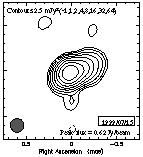
III Zw 2, the first superluminal jet in a Seyfert galaxy
Andreas Brunthaler 1 Heino Falcke1, Geoffrey C. Bower1,2, Margo F. Aller3, Hugh D. Aller3, Harri Teräsranta4, Andrew R. Lobanov1, Thomas P. Krichbaum1, Alok R. Patnaik1
1Max-Planck-Institut für Radioastronomie, Auf den Hüugel 69, D-53121 Bonn, Germany (hfalcke@mpifr-bonn.mpg.de)2Current address: NRAO, P.O. Box O, Socorro, NM 87801-0387
3Astronomy Department, University of Michigan, Ann Arbor, MI 48109-1090
4Metsähovi Radio Research Station, Metsahovintie, SF-02540 Kylmäalä, Finland
Astronomy & Astrophysics Letters, Vol. 357, L45-L48 (2000)
Abstract:
So far all relativistically boosted jets with superluminal motion have only been detected in typical radio galaxies with early type host galaxies. We have now discovered superluminal motion in the Seyfert I galaxy III Zw 2, classified as a spiral. Superluminal motion was first inferred from the spectral evolution of the source and then confirmed by VLBI observations. The lower limit for the apparent expansion speed is 1.25 +/- 0.09 c. The fact that the spectral and spatial evolution are closely linked demonstrates that we are dealing with real physical expansion. Prior to this rapid expansion we have seen a period of virtually no expansion with an expansion speed less than 0.04 c. Since III Zw 2 is also part of a sample of so called radio-intermediate quasars (RIQ), it confirms earlier predictions of superluminal motion for this source, based on the argument that RIQs could be relativistically boosted jets in radio-weak quasars and Seyfert galaxies.
Paper: Available in PostScript and (AAS)LaTex. Please send an email request to hfalcke@mpifr-bonn.mpg.de for a preprint.
Other publications can be found here.
Questions: Heino Falcke, hfalcke@mpifr-bonn.mpg.de